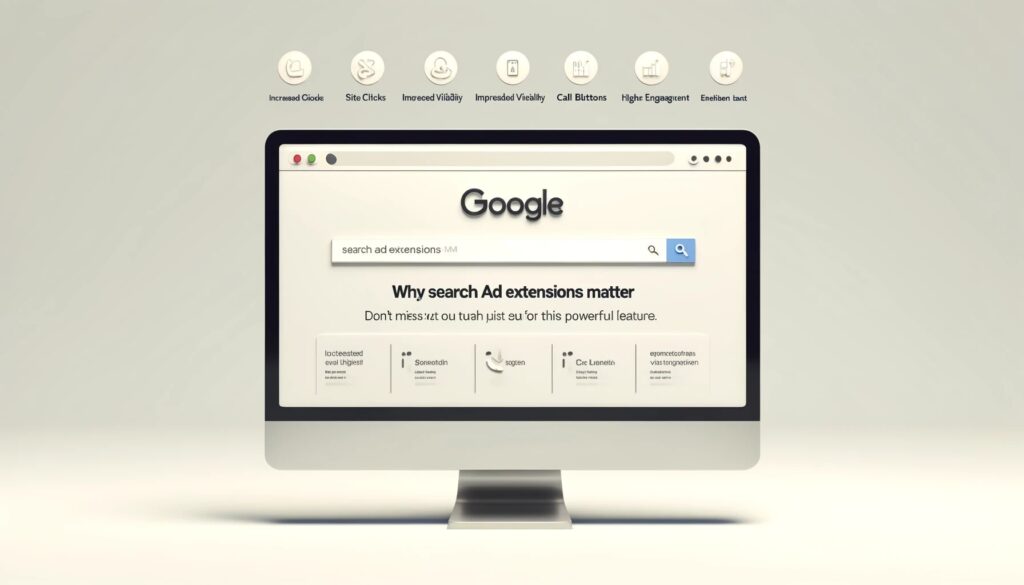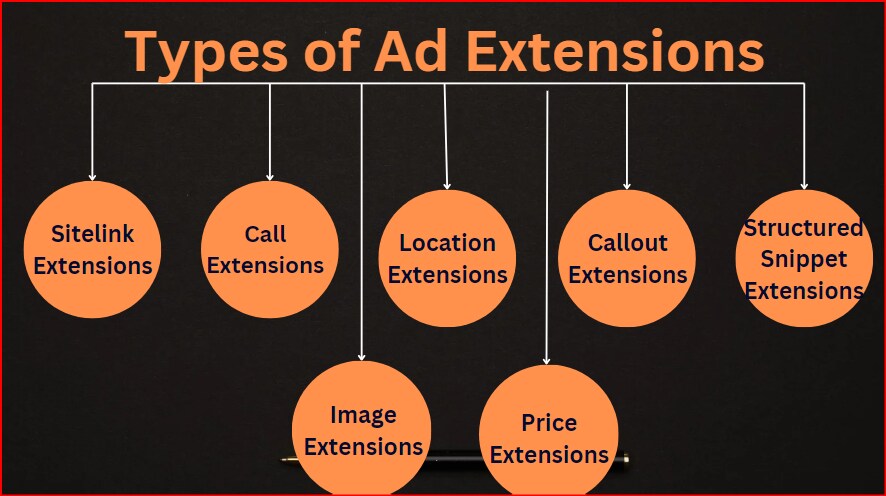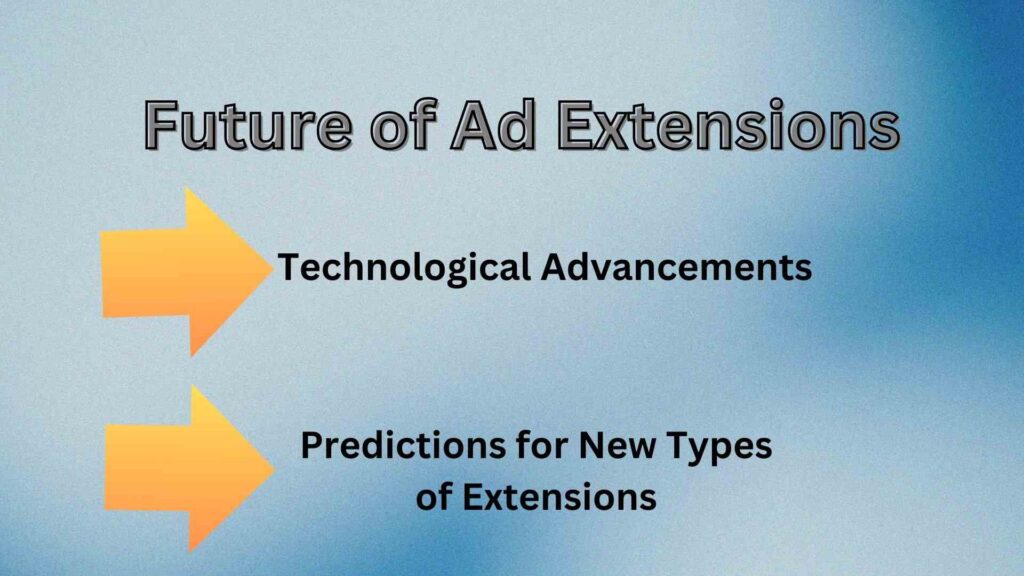Why do search ad extensions matter? Discover how utilizing ad extensions can increase visibility, improve click-through rates, and enhance the user experience, driving more qualified traffic and boosting your campaign results effectively.

Introduction
Overview of Search Ads
Search advertising is a critical component of digital marketing, allowing businesses to display ads in search engine results when users search for relevant keywords. These ads are typically text-based and can be highly targeted, appearing to potential customers who are actively searching for products or services like those offered by the advertiser. The prominence of these ads, often at the top or bottom of the search engine results page (SERP), makes them highly visible and effective at driving traffic.
Importance of Ad Extensions
Ad extensions enhance these basic search ads by providing additional information and interactive elements that can make the ads more appealing and informative. They are essentially features that expand your advertisement to make it more useful to consumers.
By including more details about the business, such as contact info, additional webpage links, product images, and more, ad extensions improve the ad’s visibility and effectiveness.
This enhancement not only aids in increasing the quality of the ad but also contributes significantly to the improvement of click-through rates (CTR), providing a direct line to more detailed content that can assist a user’s decision-making process.
This added layer of information is crucial in a competitive digital landscape, helping ads to stand out more distinctly in a crowded market.

Types of Ad Extensions
Sitelink Extensions
Sitelink extensions allow advertisers to add additional links below their main ad text, directing users to specific pages on their website. These can be used to promote top-selling products, special promotions, or important sections like customer testimonials or contact pages. Sitelinks not only enhance user engagement by offering more options but also increase the size of the ad, making it more prominent on the search results page.
Call Extensions
Call extensions add a phone number to the ad, enabling users to call the business directly from the search results. This is particularly useful for businesses where immediate contact is a significant advantage, like in services or emergency product needs. For mobile users, these extensions can include a tap-to-call function, making it incredibly easy for potential customers to make contact.
Location Extensions
Location extensions show the physical address of the business or the nearest storefront. This is ideal for local businesses looking to drive foot traffic. When users search for services “near me,” ads with location extensions are more likely to appear, providing directions and distance information, which can be crucial for attracting local customers.
Callout Extensions
Callout extensions allow advertisers to include additional descriptive text in their ads. These are not clickable links but serve to highlight unique selling points or offers like free shipping, 24/7 customer service, or exclusive deals. Callouts can be used to differentiate the ad from competitors by emphasizing specific benefits that appeal to target audiences.
Structured Snippet Extensions
Structured snippets enable advertisers to showcase a set of specific products, services, or features beneath their ad. These are predefined headers like “Models,” “Services,” or “Courses,” followed by a list of items. This type of extension is particularly effective for providing a quick snapshot of what the business offers, helping users to gauge relevance at a glance.
Image Extensions
Image extensions allow advertisers to complement their ad text with visuals. Adding images can significantly boost the attractiveness and engagement of an ad. Visuals help to capture attention more effectively than text alone, especially for products that are visually driven like clothing, vehicles, or food services.
Price Extensions
Price extensions display prices for different products or services directly in the ad. This format includes up to eight price cards that can be scrolled through, each one linking to a different part of the website. For businesses where price comparison is essential, such as in the electronics or travel industries, these extensions can give a competitive edge.
App Extensions
App extensions are designed specifically for promoting applications. They include a direct link to download the app from mobile app stores. This is highly beneficial for tech companies or any service-oriented business that offers a functional app, encouraging users to engage with the brand directly through their mobile devices.

Benefits of Using Ad Extensions
Increased Visibility
Ad extensions significantly increase the visibility of ads by adding more content and making them larger on the search results page. This enhanced visibility not only helps in catching the eye of potential customers but also improves the overall presence of the ad by covering more digital real estate. More visible ads naturally attract more attention, which can lead to higher engagement rates.
Improved Click-through Rates
One of the primary benefits of ad extensions is their ability to improve click-through rates (CTR). By providing additional links and information, these extensions make ads more interactive and informative, giving users more reasons to click. Whether it’s a direct link to a product page via a sitelink extension or a quick tap-to-call action, each extension offers a pathway that increases the likelihood of user interaction.
Enhanced User Experience
Ad extensions enhance user experience by making ads more helpful and relevant. They allow advertisers to present multiple facets of their business, from different product categories to special promotions, all from a single ad spot. This variety not only aids users in finding exactly what they need faster but also reduces the frustration of navigating through irrelevant content.
Direct Response Options
Extensions provide direct response options that encourage immediate interaction. For instance, call extensions facilitate instant phone calls, and location extensions offer quick directions to the nearest store. This immediacy can be crucial for converting interest into action, particularly in industries where quick decision-making is common, like emergency repairs or last-minute travel bookings.
Better Qualification of Traffic
By offering specific pathways and information through ad extensions, advertisers can better qualify the traffic that comes to their site. Extensions like structured snippets and price extensions help ensure that users have a good understanding of what the business offers or how much it costs before they click the ad. This means that the traffic driven to the site is more likely to be composed of individuals who are genuinely interested in the products or services, thereby increasing the likelihood of conversion.
How to Effectively Use Ad Extensions
Matching Extensions with Ad Goals
The key to effectively using ad extensions is to align them with your specific advertising goals. For instance, if the goal is to increase local store visits, location and call extensions would be ideal. For e-commerce sites aiming to boost sales, price and sitelink extensions that direct users to product pages can be more effective. Understanding the purpose of each campaign helps in choosing the right extensions that will support the desired outcomes.
Best Practices for Creating Effective Extensions
To maximize the impact of ad extensions, follow these best practices:
- Relevance: Ensure that the extensions used are relevant to the ad content and user intent.
- Clarity: Keep the text in extensions clear and concise. Each piece of added information should be easily understandable.
- Compelling CTA: Use strong call-to-action phrases that encourage users to interact with the extensions.
- Update Regularly: Keep the extensions updated with the most current information, such as new promotions or products, to maintain user interest.
Common Mistakes to Avoid
Avoid these common pitfalls when using ad extensions:
- Overloading: Do not clutter ads with too many extensions, which can overwhelm users.
- Irrelevance: Avoid using extensions that are not directly related to the ad’s message.
- Neglecting Mobile Users: Ensure all extensions are optimized for mobile devices, considering the growing number of mobile users.
Testing and Optimization Strategies
Continuous testing and optimization are crucial for maximizing the effectiveness of ad extensions. A/B testing different types of extensions can reveal what resonates best with the target audience. Regularly review performance metrics like CTR and conversion rates to adjust strategies and improve the ad’s performance over time.
Case Studies
Case Study 1: Retail Industry
In the retail sector, a major clothing brand implemented sitelink, callout, and price extensions to enhance their holiday campaign. The sitelink extensions directed users to specific product categories like “Men’s Winter Wear” and “Gifts for Her,” which significantly increased their seasonal sales. Callout extensions highlighted free shipping and holiday discounts, further enticing customers to make a purchase.
Case Study 2: Service Industry
A local plumbing service utilized location and call extensions effectively. By adding these extensions, they were able to direct users immediately to their contact and location pages, resulting in a 50% increase in emergency service calls. The direct response options provided by these extensions made it easier for customers to connect with the service in urgent situations, showcasing the practical benefits of well-chosen ad extensions in enhancing business outcomes.

Future of Ad Extensions
Technological Advancements
The future of ad extensions is likely to be shaped by ongoing technological advancements. Innovations such as AI and machine learning can enable more dynamic and personalized ad extensions. For example, extensions could automatically display based on the user’s past behavior, location, or even the time of day, enhancing the relevance and effectiveness of the ads.
Predictions for New Types of Extensions
As technology evolves, new types of ad extensions are expected to emerge. These might include VR (Virtual Reality) and AR (Augmented Reality) extensions that allow users to experience products or services in a more immersive way right from the SERPs. Voice search compatibility in extensions is also likely, catering to the increasing use of voice assistants for search queries.
Conclusion
Summary of Key Points
Ad extensions are powerful tools that enhance the visibility and effectiveness of search ads by providing additional information and interactive options. They help improve click-through rates, enhance user experience, and better qualify the traffic that reaches a website. Proper use involves aligning extensions with ad goals, adhering to best practices, and avoiding common mistakes.
Final Thoughts on the Importance of Ad Extensions
The strategic use of ad extensions is crucial for maximizing the performance of search advertising campaigns. They not only enhance the functionality and appeal of ads but also play a vital role in driving higher engagement and conversions. As search engines continue to evolve, the importance of utilizing ad extensions intelligently will only increase.
FAQs
A. What are the most commonly used ad extensions?
The most commonly used ad extensions are sitelink, callout, call, and location extensions due to their versatility and direct impact on user engagement and conversion rates.
B. How do ad extensions impact ad rank?
Ad extensions can positively impact ad rank by improving the expected click-through rate (CTR) component of the quality score. A higher CTR, driven by effective use of extensions, signals to search engines that the ad is more relevant, potentially improving its position on the SERP.
C. Can ad extensions reduce the cost-per-click?
Yes, by improving the quality score through higher engagement and relevance, ad extensions can help lower the cost-per-click (CPC). A better quality score often results in lower costs and better ad placement.
D. How often should I review and update my ad extensions?
It is advisable to review and update ad extensions at least every quarter or whenever there are significant changes to your products, services, or promotions. Regular updates ensure that the extensions remain relevant and effective.
E. Are there any ad extensions specifically beneficial for local businesses?
Yes, location extensions and call extensions are particularly beneficial for local businesses. Location extensions help drive foot traffic by showing the business’s address, while call extensions facilitate immediate contact, crucial for service-oriented local businesses.
